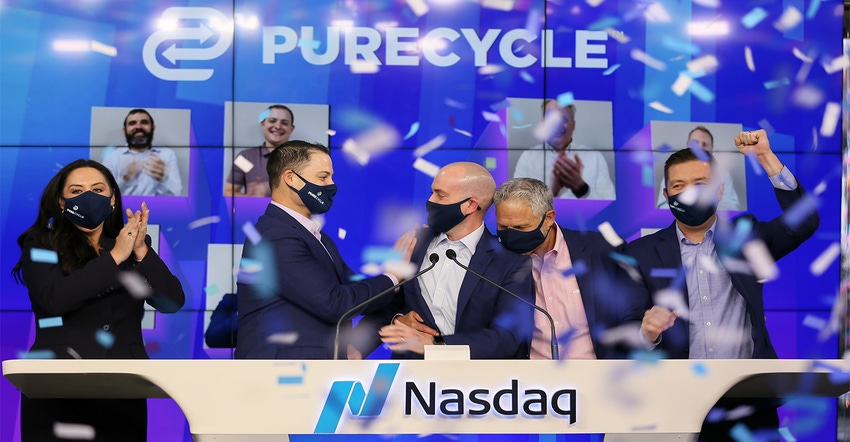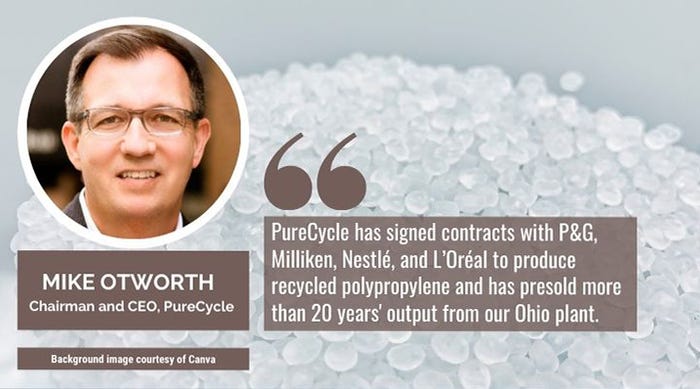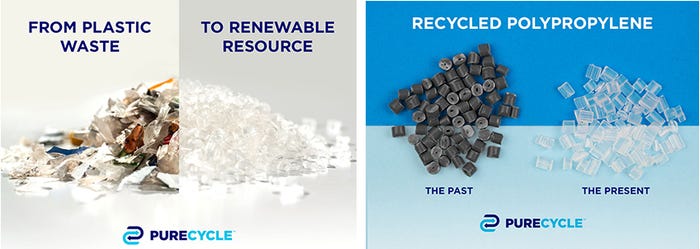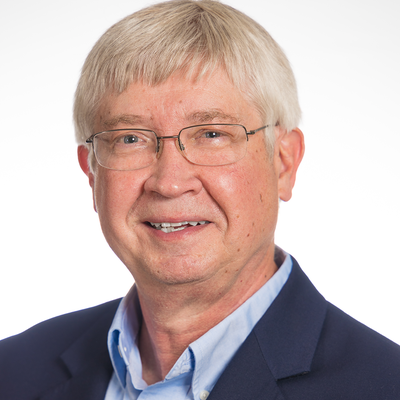PureCycle Bullish on Ultra-Pure Recycled Polypropylene
Nasdaq listing signals a bull market for PureCycle Technologies' food-quality recycled polypropylene (rPP) resin backed by big-brand buy-in and expansion.

When it comes to recycling, popularity is everything. Consider the plight of polypropylene (PP), a neglected polymer when compared to more highly recycled polymer brethren polyethylene terephthalate (PET) and high-density polyethylene (HDPE). A scant 1% of the 170 billion pounds of PP consumed last year was recycled versus almost 20% for polyethylene terephthalate (PET), according to the American Chemistry Council.
It’s an untapped resource for a circular economy model poised for development by forward-thinking companies like, for example, Procter & Gamble. P&G developed and patented a one-of-a-kind recycling technology that restores recycled PP (rPP) to virgin-like quality and licensed the rPP technology to PureCycle Technologies. Key facts about PureCycle’s process:
It targets feedstock that traditionally ends up in a landfill.
It’s a physical separation — not depolymerization — and purification doesn’t change the polymer molecules.
It uses neither catalyst nor chemical reactions, and thus it saves energy versus depolymerization.
It removes odor, color, and other contaminants that cannot be removed by traditional recycling methods, permitting the resin to be used in highly sensitive consumer applications.
The technology continues to advance in steps, most prominently on March 18 month when PureCycle Technologies was listed on the Nasdaq stock exchange.
That landmark listing is one indicator of where things stand and signals what’s ahead in 2021 and beyond.
“The consummation of this [listing] represents yet another major milestone for PureCycle, demonstrating broad market validation of our value proposition,” says PureCycle Chairman and CEO Mike Otworth. “Most importantly, we now have the increased capital market access to support the accelerated scaling required to revolutionize the transformation of waste polypropylene into sustainable products.”

Otworth answers PlasticsToday’s questions in an exclusive interview.
What sources are used — and what can be used?
Otworth: Snack bags, label film, pet food bags, and supersacks are some of the film feedstocks that we have run through our process successfully. We actively look for all types of polypropylene across film, fiber, and post-consumer rigids. While we have not finalized the percentage among our feedstock sources, we continue build on our existing partnerships to identify new sources of supply.
Why the mix of flexible and rigid materials?
Otworth: PP films are largely uncollected today. There are a lot of multilayer films out there, but there are also a lot of films made mostly of polypropylene. We’re not prioritizing collection of films as much as we are actively looking for good streams of polypropylene resin to run through our process.
What are the basic processing steps?
Otworth: Preprocessing steps depend on the type of polypropylene we receive. We built our facility to both enrich the PP of bales we receive and to densify the material so that it is optimized for our purification process. Once it is prepared, waste polypropylene is put through an extraction, filtration, and a final processing stage where it will be turned into our Ultra-Pure Recycled Polypropylene (UPRP) pellets.
How efficient is the process?
Otworth: The PureCycle process uses less energy than chemical recycling and our solvent is recycled within the process.
Has a Life Cycle Assessment been done?
Otworth: While we have done informal LCAs with the support of our partners, we are in the process of conducting a formal LCA that will be complete in Q2 2021.
What's your pricing model?
Otworth: We view our resin as a premium to virgin and it will be priced accordingly.
What’s the production status?
Otworth: PureCycle’s initial operations will start in the US with our first industrial plant under construction in Ironton, OH [Ed. Note: Plant capacity will be approximately 107 million pounds per year when fully operational.]
This year our priority is to break ground on the subsequent plant sites and also build on our existing offtake and feedstock partnerships. Our next phase of plants will be based in both the US and European Union.
What else can you say about the forthcoming EU facility?
Otworth: This is still in discussion. We have a 2020 agreement with Total to develop a strategic partnership in plastic recycling. As part of the agreement, Total undertakes to purchase part of the output of PureCycle’s facility in the US and to assess the interest of developing a new plant together in Europe.
We understand that artificial intelligence is used in your process, can you provide more details?
Otworth: For us, artificial intelligence is applied to analyze all aspects of the production process, including process safety, environmental controls, process optimization, machinery health, maintenance needs (and timing), and asset integrity.
It includes machine learning to automatically and continually model PureCycle’s complex solvent-based extraction processes to reach higher levels of control autonomy, thus eliminating human errors creating a safer, a more environmentally sound, and a more efficient recycling system.

What’s happening from a regulatory standpoint?
Otworth: We will be applying for FDA Letter of No Objection (LNO) for food packaging applications and have our resin tested head-to-head against virgin resin. Independent studies already show that PureCycle resin performs on par with virgin resin at a letdown ratio (LDR) of 25%, 50%, 75% and 100%.
What’s the in-market status…is any brand or company using or testing?
Otworth: Our Feedstock Evaluation Unit came online in July 2019 and since that time we have provided initial sample sets to both current and prospective customers.
Our first industrial-scale plant will come online in Q4 2022, and we’re very excited about the co-branding opportunities that exist to get our resin out onto the shelves. PureCycle has signed contracts with P&G, Milliken, Nestlé and L’Oréal to produce rPP and has presold more than 20 years of output from our Ohio plant.
With PP recycling rates so low, what can be done to be increase that?
Otworth: More curbside collection of PP at the national level, and higher value applications to be made from rPP.
What’s your biggest challenge?
Otworth: Sourcing PP feedstocks globally.
What’s a takeaway for readers?
Otworth: We are working quickly to build capacity to support the markets’ needs for virgin-like recycled polypropylene.
About the Author(s)
You May Also Like




